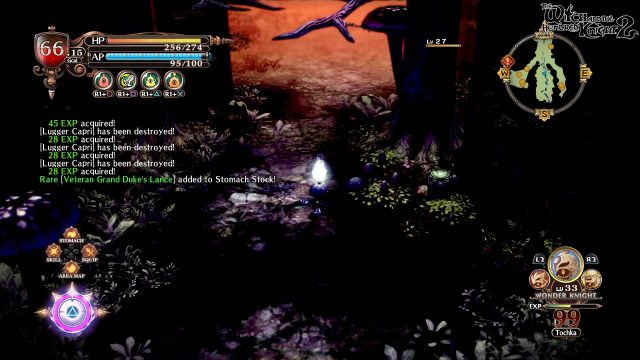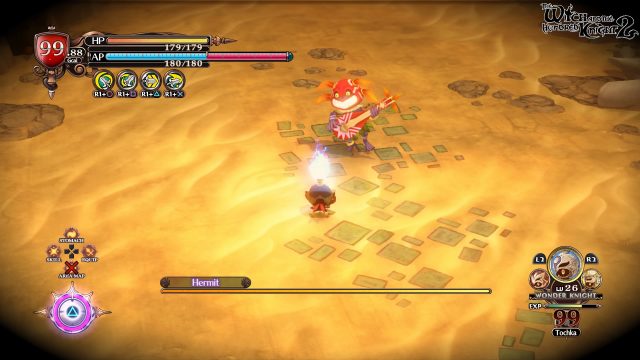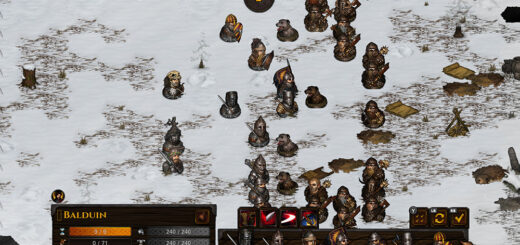The Witch and the Hundred Knight 2 Review
The Inquisition Is Here to Stay
After creating a game best known for an incredibly unlikable main character and an infamous scene involving a mouse, Nippon Ichi Software did some retooling for the sequel, The Witch and the Hundred Knight 2. The second game serves as a soft reboot, sharing the art style and themes of the original but little from a narrative standpoint, making it easy for players who skipped the first game to dive in. However, RPGamers should exercise extreme caution. While the cast may be less repulsive, that doesn’t make up for mind-numbingly repetitive gameplay.
Hundred Knight 2 stars Amalie, a young girl who is banished from her village because her younger sister, Milm, has contracted Hexensyndrome, otherwise known as the witch’s disease. Milm now has a third eye on her forehead and once it opens, she will become an awakened witch and lose her personality. To get Milm treatment, Amalie joins the Weisse Ritter, an organization dedicated to treating witch’s disease and exterminating awakened witches. Unfortunately, the procedure to cure Milm goes horribly wrong and she becomes an awakened witch who goes by the name Chelka. Since Chelka needs a minion, she turns a doll into the titular Hundred Knight. Now Amalie’s beloved sister has become one of the beings that she has vowed to exterminate. All is not lost, as Milm manages to momentarily wrestle back control of her body, giving Amalie hope that there might be some way to save her. Now Amalie must play two roles: moving up the ranks of the Weisse Ritter by tackling witches in hopes of learning about a cure for her sister, while also protecting this awakened witch inhabiting her sister’s body from discovery and extermination.
While the narrative focuses on the two sisters, players control Hundred Knight. Hundred Knight is about as verbose as might be expected of a doll brought to life, but there are occasional instances where players get to choose responses to orders from the sisters. In visual novel fashion, some of these choices even influence the ending. Visual novel influences also show up in the sheer verbosity of the game; probably half of the game’s length is exposition and it leads to the pacing being a bit slow for an action game. The story itself is engaging with a few telegraphed, yet interesting twists. Amalie’s struggle to save her sister while hiding Chelka from the Weiss Ritter makes for an interesting tale and Amalie is a sympathetic, likable character. It’s just a shame that every time a crisis happens, she is shunted aside, and Hundred Knight comes to save the day.
The Witch and the Hundred Knight 2 is an action RPG sporting procedurally-generated dungeons. This results in stages that boil down to boring corridors, all more or less looking like one another. Patterns repeat over and over again, with only the occasional downed tree, big hole, or stream to break up the otherwise unrelenting monotony. While there are occasional branches off the main path that may hold a treasure chest or challenging optional enemy, the repeating terrain design and limited locales — such as forest, magic poisoned forest, snowy forest, and wasteland — will quickly sap players of any interest in spending unnecessary time in dungeons. There is also a fairly small stable of enemies that rarely get so much as a palette swap. Players will be fighting many of the same enemies the entire game, albeit with higher levels. The character designs don’t look that impressive and the game’s graphics as a whole lack the sort of detail that is expected of modern RPGs.

Nobody expects the Spanish Inquisition!
The exposition is primarily accomplished through the use of character portraits and text boxes with no cutscenes to be found. The game is fully voice-acted in English, with an option to use Japanese voices, and the main cast does a good job of bringing the material to life. The music is one of the only highlights of this title, with mystical melodies punctuated by eclectic interjections for the lighthearted portions. Composed by Tenpei Sato, who also composed the music for the Disgaea series, the soundtrack is one thing about Hundred Knight 2 that doesn’t get old with repetition.
That leaves the combat, which, while having some interesting ideas, ultimately dooms Hundred Knight 2. Combat revolves around three different meters: a traditional HP meter, an adrenaline point (AP) meter, and a meter measuring Hundred Knight’s energy in Gigacalories. The AP meter increases as Hundred Knight attacks enemies and can be spent on special attacks and other active skills. Gigacalories act a bit like stamina. Hundred Knight’s health is continuously increasing so long as the player has Gigacalories to spare. However, Gigacalories are constantly burned up and moves such as running and roll-dodging increase the rate they are used up. Running out of Gigacalories is rarely an issue outside of boss encounters, however, and even then there are items that can be purchased to replenish them or Hundred Knight can just digest some of the items stored in his stomach during the current dungeon run.
Hundred Knight 2 also employs a rudimentary weapon weakness system with swords, staffs, hammers, lances, and spears all doing either slash, blunt, or magic damage. It’s common for enemies to have a weakness to only one of these types of damage and be near impervious to attacks by the other types unless Hundred Knight is many levels above them. That means all the different weapon types will need to be employed. Rather than just equipping a single weapon at a time and having a traditional combo system, Hundred Knight 2 forces the player to equip five different weapons. These are activated in order each time the attack button is pressed, with an attack bonus given to the later weapons in the order. This allows players to create customized attack combos for different situations.

Is this a forest palette swap gone bad?
While this system sounds fine in theory, in practice it leaves plenty to be desired, with most of the problems stemming from the way weapons handle. Swords and other slashing weapons have a satisfyingly quick action, but hammers have an incredibly slow, lumbering animation that can ruin the flow whenever enemies that are weak to blunt attacks show up. This is supposed to be balanced by the hammer’s high chance of stunning enemies, allowing time for those slow attacks, but tougher enemies (including bosses) appear impervious to stun, making those encounters poorly balanced. The magic staffs aren’t very responsive, and it is tricky to figure out what sort of close or long-range magic will suit the situation ahead of time. Also, most spells are slow to cast, making an incongruous match for Hundred Knight 2‘s action combat. All of this wouldn’t be such a problem if players could choose the weapons they enjoyed, but Hundred Knight 2‘s weapon weakness system dictates which weapons must be employed at any one time.
To keep from constantly having to change Hundred Knight’s equipment, facets are added to the combat repertoire. These are different forms of Hundred Knight that can be switched between during combat, each having different strengths and weakness with weapon types, making them suited to different loadouts. The facets can be readily changed on the fly, allowing players to swap playstyles to suit the situation.
Hundred Knight 2 also incorporates an extensive weapon and armor customization system. Enemies randomly drop weapons, armor, and items and these can be used to upgrade other weapons and armor. The upgrade system can be just as important as leveling up Hundred Knight; there is a gulf between a basic weapon picked up in a dungeon and a legendary weapon that has been upgraded to level 99. Since there are five weapon slots for each facet and a variety of differently equipped facets will be needed to deal with the weapon weakness system, the upgrade system isn’t just added depth, but required for progress. Players will be managing numerous weapons and spending too much time in menus sifting through the hundreds of items that will accumulate through dungeon runs. This means spending plenty of time attempting to determine what to keep and what to scrap. It is an interesting addition to the game, but the execution is lacking and embracing this system means lots of grinding for items in the aforementioned bland, repetitive dungeons.

With such a friendly smile, why is he a hermit?
The game has one last trick up its sleeve to attempt to alleviate the weapon problems, but this also falls short. Hundred Knight 2 has rare weapons that flip the default weapon affinities, meaning it’s possible to find a sword that can do magic or blunt damage. While this could have fixed some of the problems with using sluggish weapons, actually acquiring one is left purely to chance and even if one is acquired, the quality of the weapon is also up to chance and may be poor. It seems that grinding for rare drops and materials to upgrade weapons is the intended loop, but when the combat isn’t fun, the proffered solution of more combat isn’t exactly an enticing prospect.
There simply isn’t enough variety in enemy encounters to carry a twenty-hour game. Even the positioning of enemies repeats over and over throughout. It makes the action portion of the game an incredible slog. The controls themselves feel sluggish; it’s easy to tap the attack button multiple times and lock Hundred Knight into an unintentional combo because the controls don’t feel responsive to player input. The default camera speed is slow and, though it can be changed in the options menu, there are several occasions when the camera is blocked by the environment. Not an optimal situation during a tense boss battle. Hundred Knight also has an ability to cease movement and dramatically increase his natural healing rate by pressing in the left stick. Several deaths can be attributed to inadvertently pressing in the left stick during spirited moments of evasion and watching the boss finish off a now-stationary Hundred Knight.
The controls aren’t the only thing frustrating about the boss encounters, which are often exercises in identifying the pattern and slowly using a weakness against the boss. Some are incredibly easy — one with a weakness to magic is easy to defeat without the boss ever touching Hundred Knight — while others have frustratingly small openings for Hundred Knight to attack. One boss particularly has an attack that heals the boss, plus another that can kill Hundred Knight in a single blow. It’s maddening trying to figure out the distance that keeps Hundred Knight away from these attacks, all while catching on to the timing to be able to dart in and rack up a single hit, before retreating to avoid the healing attack that would negate that effort. Too many of these boss battles come down to twenty seconds of avoiding attacks, rushing in to get one attack in — not two, or the boss might turn and take off half of the player’s health — and running away to repeat the cycle.
The Witch and the Hundred Knight 2 is the worst gaming experience I’ve had in recent memory. The longer I played the game, the more negative my opinions became. While it started out as a harmless, bland action RPG, it beat me into submission with repetitive dungeons, bad combat, and poorly-designed boss encounters. While there may be a few interesting ideas in the story, it’s not worth suffering through the dungeons and needlessly verbose scenes to experience them. The next time NIS makes an action RPG, it needs to wipe the slate clean because Hundred Knight 2 doesn’t have enough good ideas to be worth saving.


Story takes interesting twists
Catchy music
Repetitive, boring dungeons
Not enough enemy variety
Frustrating boss battles
Sluggish combat






Any game that earns a 1 on battle system is unplayable as far as I’m concerned. The game could have a 5 on story and it still wouldn’t be worth the torture. Just read a synopsis/find the script if it’s that good, but there’s nothing that’s going to make playing through such a terrible battle system worthwhile.
That’s sorta how I feel as well. With HK2, I was almost more annoyed that the game has some interesting ideas but none of them work well together. I’m sure there are some people that may really enjoy the depth of customization (you can tell this game comes from the same company that makes Disgaea) but unlocking that customization means lots of grinding in the surprisingly repetitive random dungeons. Bleck
Oh well, I’d had hopes for the sequel. Back to looking for the good games…
So it’s an improvement? :3